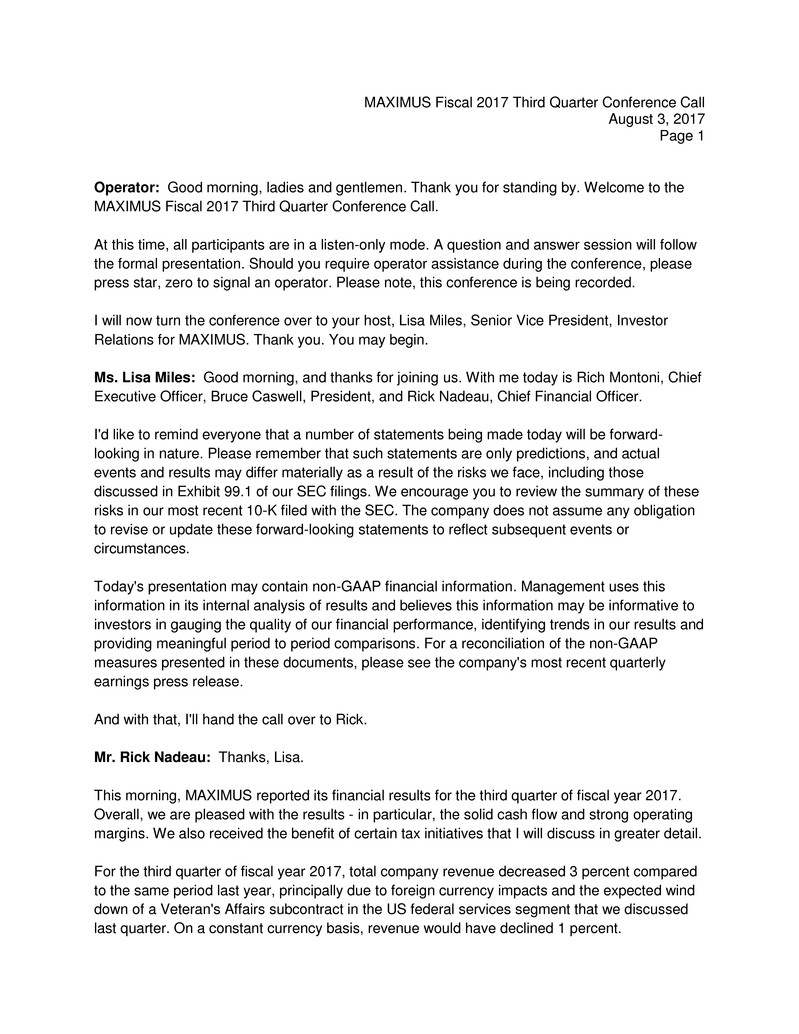
MAXIMUS Fiscal 2017 Third Quarter Conference Call
August 3, 2017
Page 1
Operator: Good morning, ladies and gentlemen. Thank you for standing by. Welcome to the
MAXIMUS Fiscal 2017 Third Quarter Conference Call.
At this time, all participants are in a listen-only mode. A question and answer session will follow
the formal presentation. Should you require operator assistance during the conference, please
press star, zero to signal an operator. Please note, this conference is being recorded.
I will now turn the conference over to your host, Lisa Miles, Senior Vice President, Investor
Relations for MAXIMUS. Thank you. You may begin.
Ms. Lisa Miles: Good morning, and thanks for joining us. With me today is Rich Montoni, Chief
Executive Officer, Bruce Caswell, President, and Rick Nadeau, Chief Financial Officer.
I'd like to remind everyone that a number of statements being made today will be forward-
looking in nature. Please remember that such statements are only predictions, and actual
events and results may differ materially as a result of the risks we face, including those
discussed in Exhibit 99.1 of our SEC filings. We encourage you to review the summary of these
risks in our most recent 10-K filed with the SEC. The company does not assume any obligation
to revise or update these forward-looking statements to reflect subsequent events or
circumstances.
Today's presentation may contain non-GAAP financial information. Management uses this
information in its internal analysis of results and believes this information may be informative to
investors in gauging the quality of our financial performance, identifying trends in our results and
providing meaningful period to period comparisons. For a reconciliation of the non-GAAP
measures presented in these documents, please see the company's most recent quarterly
earnings press release.
And with that, I'll hand the call over to Rick.
Mr. Rick Nadeau: Thanks, Lisa.
This morning, MAXIMUS reported its financial results for the third quarter of fiscal year 2017.
Overall, we are pleased with the results - in particular, the solid cash flow and strong operating
margins. We also received the benefit of certain tax initiatives that I will discuss in greater detail.
For the third quarter of fiscal year 2017, total company revenue decreased 3 percent compared
to the same period last year, principally due to foreign currency impacts and the expected wind
down of a Veteran's Affairs subcontract in the US federal services segment that we discussed
last quarter. On a constant currency basis, revenue would have declined 1 percent.
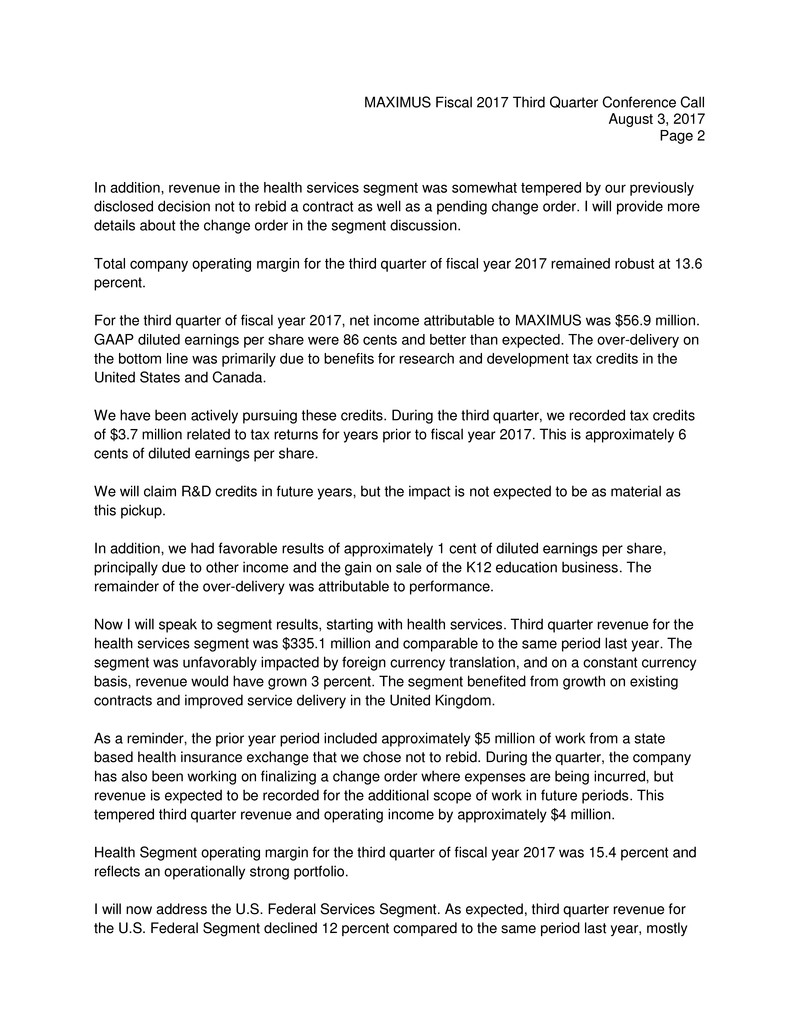
MAXIMUS Fiscal 2017 Third Quarter Conference Call
August 3, 2017
Page 2
In addition, revenue in the health services segment was somewhat tempered by our previously
disclosed decision not to rebid a contract as well as a pending change order. I will provide more
details about the change order in the segment discussion.
Total company operating margin for the third quarter of fiscal year 2017 remained robust at 13.6
percent.
For the third quarter of fiscal year 2017, net income attributable to MAXIMUS was $56.9 million.
GAAP diluted earnings per share were 86 cents and better than expected. The over-delivery on
the bottom line was primarily due to benefits for research and development tax credits in the
United States and Canada.
We have been actively pursuing these credits. During the third quarter, we recorded tax credits
of $3.7 million related to tax returns for years prior to fiscal year 2017. This is approximately 6
cents of diluted earnings per share.
We will claim R&D credits in future years, but the impact is not expected to be as material as
this pickup.
In addition, we had favorable results of approximately 1 cent of diluted earnings per share,
principally due to other income and the gain on sale of the K12 education business. The
remainder of the over-delivery was attributable to performance.
Now I will speak to segment results, starting with health services. Third quarter revenue for the
health services segment was $335.1 million and comparable to the same period last year. The
segment was unfavorably impacted by foreign currency translation, and on a constant currency
basis, revenue would have grown 3 percent. The segment benefited from growth on existing
contracts and improved service delivery in the United Kingdom.
As a reminder, the prior year period included approximately $5 million of work from a state
based health insurance exchange that we chose not to rebid. During the quarter, the company
has also been working on finalizing a change order where expenses are being incurred, but
revenue is expected to be recorded for the additional scope of work in future periods. This
tempered third quarter revenue and operating income by approximately $4 million.
Health Segment operating margin for the third quarter of fiscal year 2017 was 15.4 percent and
reflects an operationally strong portfolio.
I will now address the U.S. Federal Services Segment. As expected, third quarter revenue for
the U.S. Federal Segment declined 12 percent compared to the same period last year, mostly
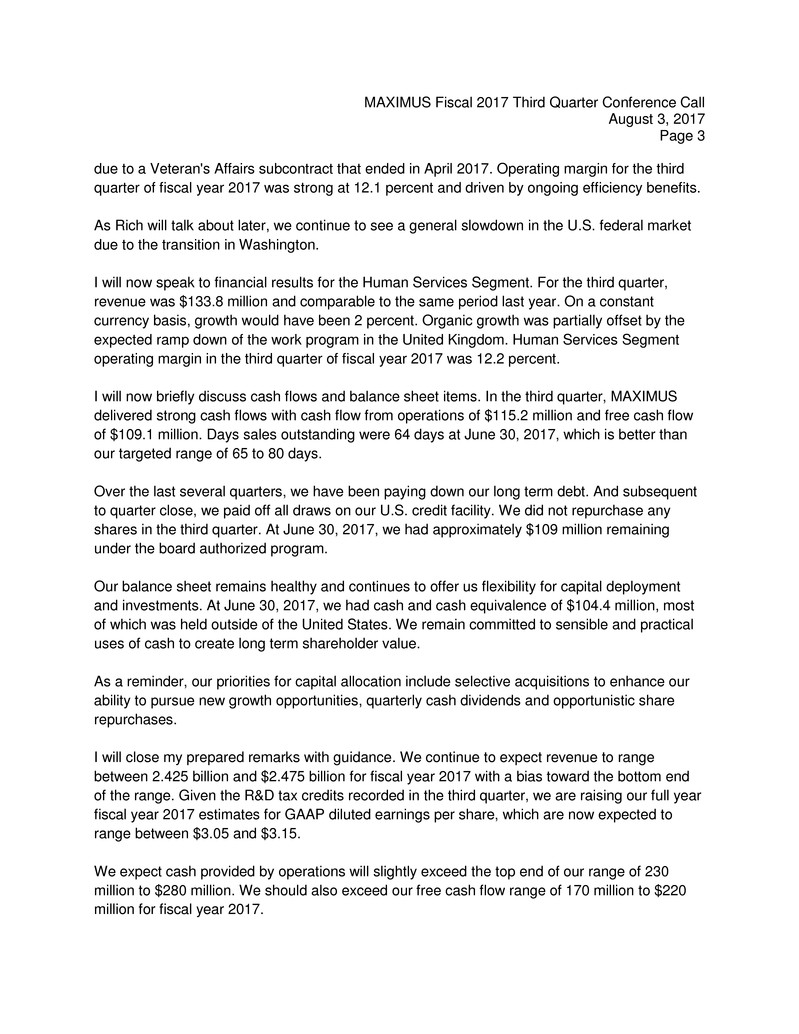
MAXIMUS Fiscal 2017 Third Quarter Conference Call
August 3, 2017
Page 3
due to a Veteran's Affairs subcontract that ended in April 2017. Operating margin for the third
quarter of fiscal year 2017 was strong at 12.1 percent and driven by ongoing efficiency benefits.
As Rich will talk about later, we continue to see a general slowdown in the U.S. federal market
due to the transition in Washington.
I will now speak to financial results for the Human Services Segment. For the third quarter,
revenue was $133.8 million and comparable to the same period last year. On a constant
currency basis, growth would have been 2 percent. Organic growth was partially offset by the
expected ramp down of the work program in the United Kingdom. Human Services Segment
operating margin in the third quarter of fiscal year 2017 was 12.2 percent.
I will now briefly discuss cash flows and balance sheet items. In the third quarter, MAXIMUS
delivered strong cash flows with cash flow from operations of $115.2 million and free cash flow
of $109.1 million. Days sales outstanding were 64 days at June 30, 2017, which is better than
our targeted range of 65 to 80 days.
Over the last several quarters, we have been paying down our long term debt. And subsequent
to quarter close, we paid off all draws on our U.S. credit facility. We did not repurchase any
shares in the third quarter. At June 30, 2017, we had approximately $109 million remaining
under the board authorized program.
Our balance sheet remains healthy and continues to offer us flexibility for capital deployment
and investments. At June 30, 2017, we had cash and cash equivalence of $104.4 million, most
of which was held outside of the United States. We remain committed to sensible and practical
uses of cash to create long term shareholder value.
As a reminder, our priorities for capital allocation include selective acquisitions to enhance our
ability to pursue new growth opportunities, quarterly cash dividends and opportunistic share
repurchases.
I will close my prepared remarks with guidance. We continue to expect revenue to range
between 2.425 billion and $2.475 billion for fiscal year 2017 with a bias toward the bottom end
of the range. Given the R&D tax credits recorded in the third quarter, we are raising our full year
fiscal year 2017 estimates for GAAP diluted earnings per share, which are now expected to
range between $3.05 and $3.15.
We expect cash provided by operations will slightly exceed the top end of our range of 230
million to $280 million. We should also exceed our free cash flow range of 170 million to $220
million for fiscal year 2017.

MAXIMUS Fiscal 2017 Third Quarter Conference Call
August 3, 2017
Page 4
We now project our effective income tax rate for the fourth quarter and the full fiscal year 2017
to range between 33 and 34 percent. As we have previously mentioned, there is a new
accounting requirement that the windfall benefit from tax deductions in excess of book
deductions for stock compensation be recorded as an adjustment to the tax provision starting
this fiscal year. This means that the effective income tax rate for the fourth quarter of fiscal year
2017 will depend upon the stock price at September 30, 2017, which is the date that restricted
stock units will vest. This will reduce our effective income tax rate as compared to prior years
and also introduces more variability to the tax rate estimate we provide.
Thank you for your continued interest, and now I will turn the call over to Rich.
Mr. Rich Montoni: Thank you, Rick, and good morning, everyone. We had a good third quarter
with healthy operating margins and cash flows, and we remain on pace for a solid fiscal 2017.
The core business remains strong, and the long term macro environment remains favorable.
Investors ask about short-term and long-term growth, so this morning, I will address some of the
most common questions head on.
Our view of the short term has not changed since the last quarter. We are experiencing a pause
in the industry. While we still view this as temporary, it is impractical to speculate as to when we
might see a break in the pause. In the United States, we are currently seeing smaller deal sizes,
reflecting budget uncertainty, increased delays and longer procurement cycles, reflecting policy
uncertainty and less deal flow of opportunities overall.
Further, staffing shortfalls within various agencies continue to hinder the decision making
progress at both the federal and the state level. This leads us to believe that single digit top line
growth is a more realistic target in the short term until new priorities, legislation and programs
have solidified.
But, longer term, MAXIMUS possesses a healthy and stable portfolio, which is a good
foundation to build upon. While we may be benefiting in the short term from our stable portfolio,
we are actively planting seeds for long term future growth. This includes new growth
opportunities that allow us to augment and further leverage our core capabilities.
It is our management commitment to identify and invest in these growth opportunities. When we
consider our path for the next five years, the macro environment is as favorable as it's been in a
long time. Governments increasingly require solutions to manage aging populations, individuals
with more complex health needs and growing caseloads in a cost effective and efficient way.
So, we feel we have ample longer term opportunities as governments around the world address
these macro trends.
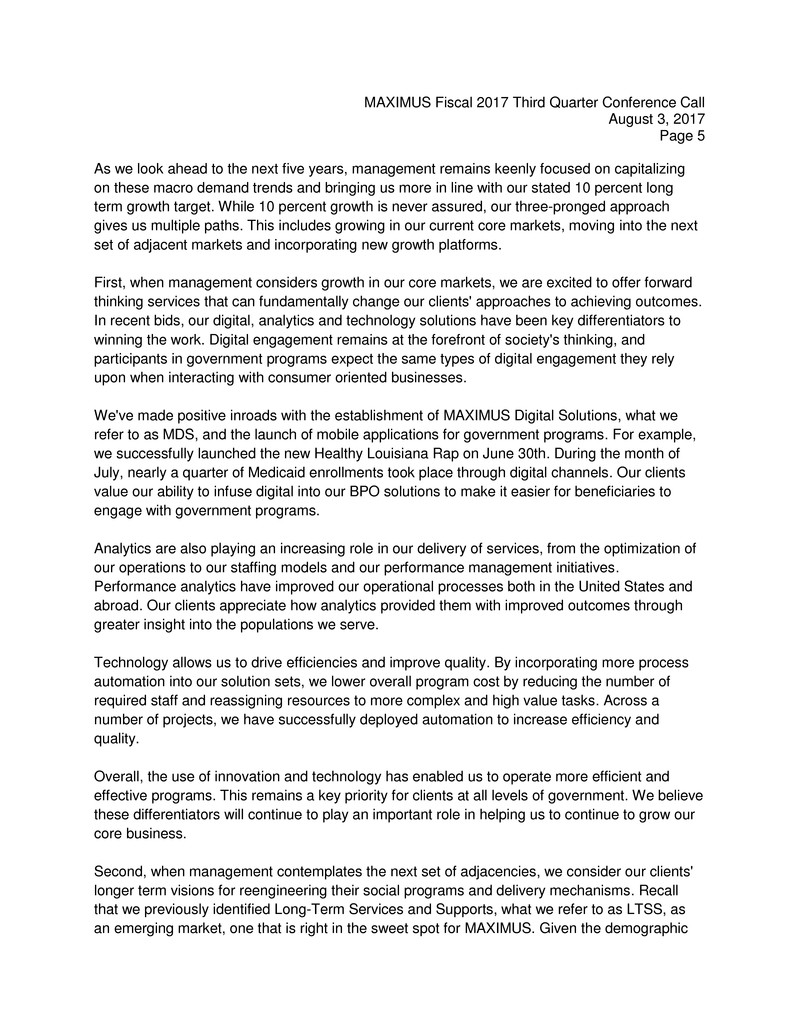
MAXIMUS Fiscal 2017 Third Quarter Conference Call
August 3, 2017
Page 5
As we look ahead to the next five years, management remains keenly focused on capitalizing
on these macro demand trends and bringing us more in line with our stated 10 percent long
term growth target. While 10 percent growth is never assured, our three-pronged approach
gives us multiple paths. This includes growing in our current core markets, moving into the next
set of adjacent markets and incorporating new growth platforms.
First, when management considers growth in our core markets, we are excited to offer forward
thinking services that can fundamentally change our clients' approaches to achieving outcomes.
In recent bids, our digital, analytics and technology solutions have been key differentiators to
winning the work. Digital engagement remains at the forefront of society's thinking, and
participants in government programs expect the same types of digital engagement they rely
upon when interacting with consumer oriented businesses.
We've made positive inroads with the establishment of MAXIMUS Digital Solutions, what we
refer to as MDS, and the launch of mobile applications for government programs. For example,
we successfully launched the new Healthy Louisiana Rap on June 30th. During the month of
July, nearly a quarter of Medicaid enrollments took place through digital channels. Our clients
value our ability to infuse digital into our BPO solutions to make it easier for beneficiaries to
engage with government programs.
Analytics are also playing an increasing role in our delivery of services, from the optimization of
our operations to our staffing models and our performance management initiatives.
Performance analytics have improved our operational processes both in the United States and
abroad. Our clients appreciate how analytics provided them with improved outcomes through
greater insight into the populations we serve.
Technology allows us to drive efficiencies and improve quality. By incorporating more process
automation into our solution sets, we lower overall program cost by reducing the number of
required staff and reassigning resources to more complex and high value tasks. Across a
number of projects, we have successfully deployed automation to increase efficiency and
quality.
Overall, the use of innovation and technology has enabled us to operate more efficient and
effective programs. This remains a key priority for clients at all levels of government. We believe
these differentiators will continue to play an important role in helping us to continue to grow our
core business.
Second, when management contemplates the next set of adjacencies, we consider our clients'
longer term visions for reengineering their social programs and delivery mechanisms. Recall
that we previously identified Long-Term Services and Supports, what we refer to as LTSS, as
an emerging market, one that is right in the sweet spot for MAXIMUS. Given the demographic
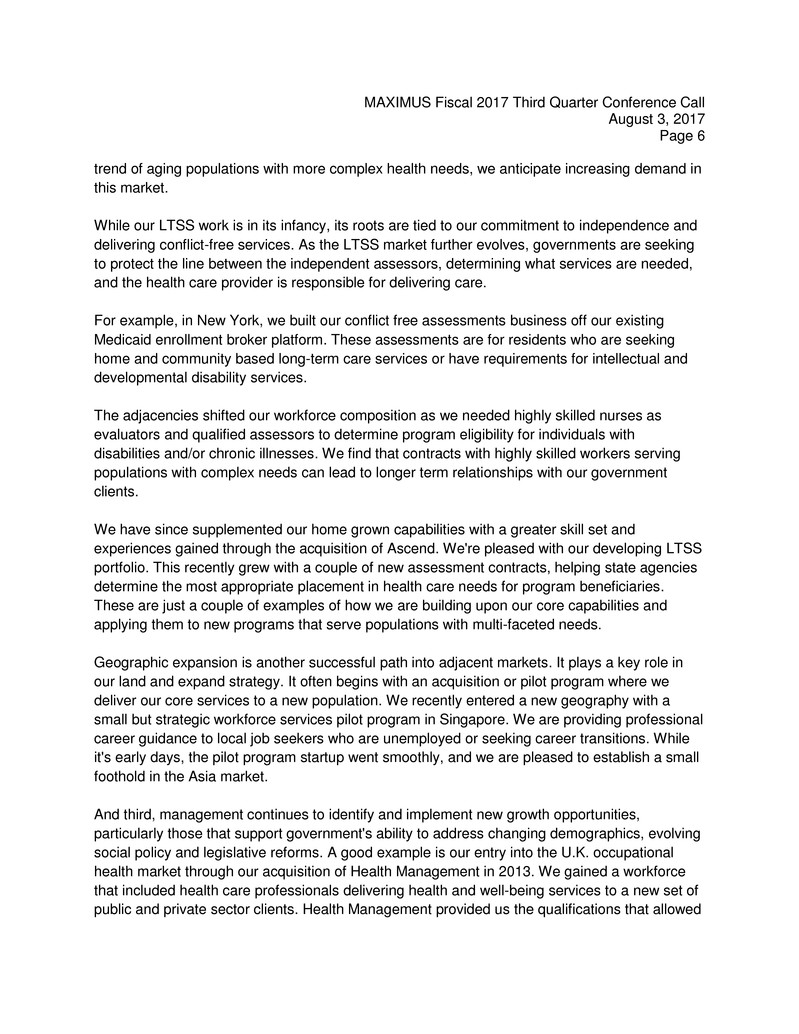
MAXIMUS Fiscal 2017 Third Quarter Conference Call
August 3, 2017
Page 6
trend of aging populations with more complex health needs, we anticipate increasing demand in
this market.
While our LTSS work is in its infancy, its roots are tied to our commitment to independence and
delivering conflict-free services. As the LTSS market further evolves, governments are seeking
to protect the line between the independent assessors, determining what services are needed,
and the health care provider is responsible for delivering care.
For example, in New York, we built our conflict free assessments business off our existing
Medicaid enrollment broker platform. These assessments are for residents who are seeking
home and community based long-term care services or have requirements for intellectual and
developmental disability services.
The adjacencies shifted our workforce composition as we needed highly skilled nurses as
evaluators and qualified assessors to determine program eligibility for individuals with
disabilities and/or chronic illnesses. We find that contracts with highly skilled workers serving
populations with complex needs can lead to longer term relationships with our government
clients.
We have since supplemented our home grown capabilities with a greater skill set and
experiences gained through the acquisition of Ascend. We're pleased with our developing LTSS
portfolio. This recently grew with a couple of new assessment contracts, helping state agencies
determine the most appropriate placement in health care needs for program beneficiaries.
These are just a couple of examples of how we are building upon our core capabilities and
applying them to new programs that serve populations with multi-faceted needs.
Geographic expansion is another successful path into adjacent markets. It plays a key role in
our land and expand strategy. It often begins with an acquisition or pilot program where we
deliver our core services to a new population. We recently entered a new geography with a
small but strategic workforce services pilot program in Singapore. We are providing professional
career guidance to local job seekers who are unemployed or seeking career transitions. While
it's early days, the pilot program startup went smoothly, and we are pleased to establish a small
foothold in the Asia market.
And third, management continues to identify and implement new growth opportunities,
particularly those that support government's ability to address changing demographics, evolving
social policy and legislative reforms. A good example is our entry into the U.K. occupational
health market through our acquisition of Health Management in 2013. We gained a workforce
that included health care professionals delivering health and well-being services to a new set of
public and private sector clients. Health Management provided us the qualifications that allowed
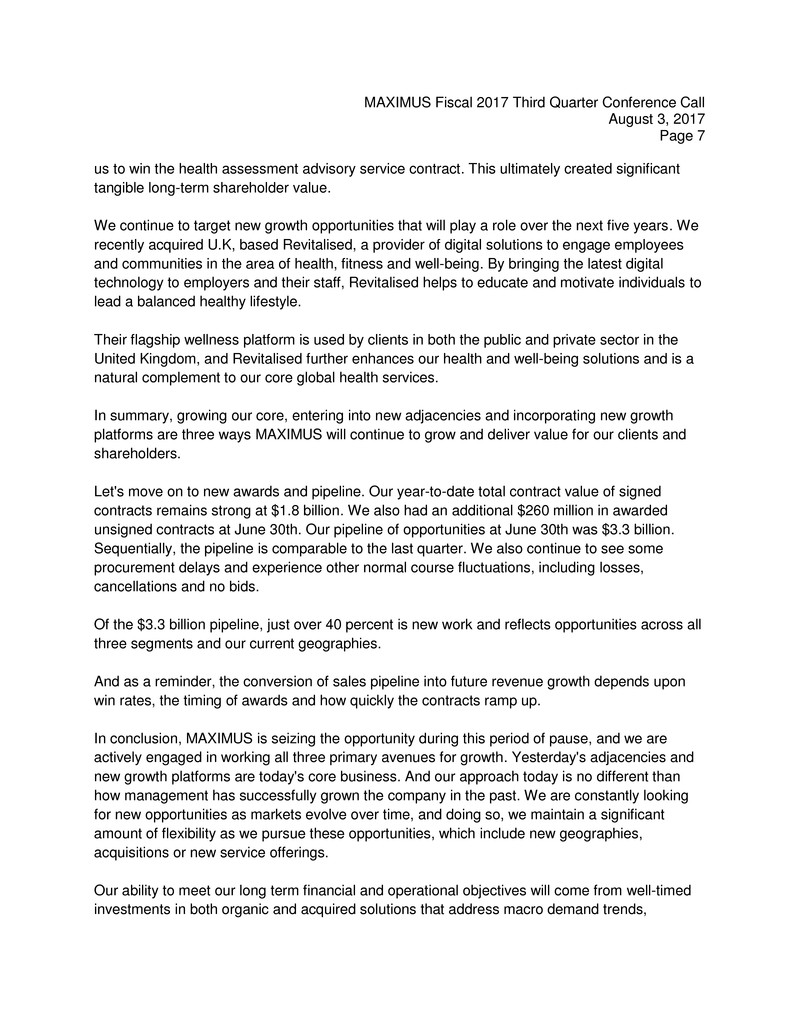
MAXIMUS Fiscal 2017 Third Quarter Conference Call
August 3, 2017
Page 7
us to win the health assessment advisory service contract. This ultimately created significant
tangible long-term shareholder value.
We continue to target new growth opportunities that will play a role over the next five years. We
recently acquired U.K, based Revitalised, a provider of digital solutions to engage employees
and communities in the area of health, fitness and well-being. By bringing the latest digital
technology to employers and their staff, Revitalised helps to educate and motivate individuals to
lead a balanced healthy lifestyle.
Their flagship wellness platform is used by clients in both the public and private sector in the
United Kingdom, and Revitalised further enhances our health and well-being solutions and is a
natural complement to our core global health services.
In summary, growing our core, entering into new adjacencies and incorporating new growth
platforms are three ways MAXIMUS will continue to grow and deliver value for our clients and
shareholders.
Let's move on to new awards and pipeline. Our year-to-date total contract value of signed
contracts remains strong at $1.8 billion. We also had an additional $260 million in awarded
unsigned contracts at June 30th. Our pipeline of opportunities at June 30th was $3.3 billion.
Sequentially, the pipeline is comparable to the last quarter. We also continue to see some
procurement delays and experience other normal course fluctuations, including losses,
cancellations and no bids.
Of the $3.3 billion pipeline, just over 40 percent is new work and reflects opportunities across all
three segments and our current geographies.
And as a reminder, the conversion of sales pipeline into future revenue growth depends upon
win rates, the timing of awards and how quickly the contracts ramp up.
In conclusion, MAXIMUS is seizing the opportunity during this period of pause, and we are
actively engaged in working all three primary avenues for growth. Yesterday's adjacencies and
new growth platforms are today's core business. And our approach today is no different than
how management has successfully grown the company in the past. We are constantly looking
for new opportunities as markets evolve over time, and doing so, we maintain a significant
amount of flexibility as we pursue these opportunities, which include new geographies,
acquisitions or new service offerings.
Our ability to meet our long term financial and operational objectives will come from well-timed
investments in both organic and acquired solutions that address macro demand trends,
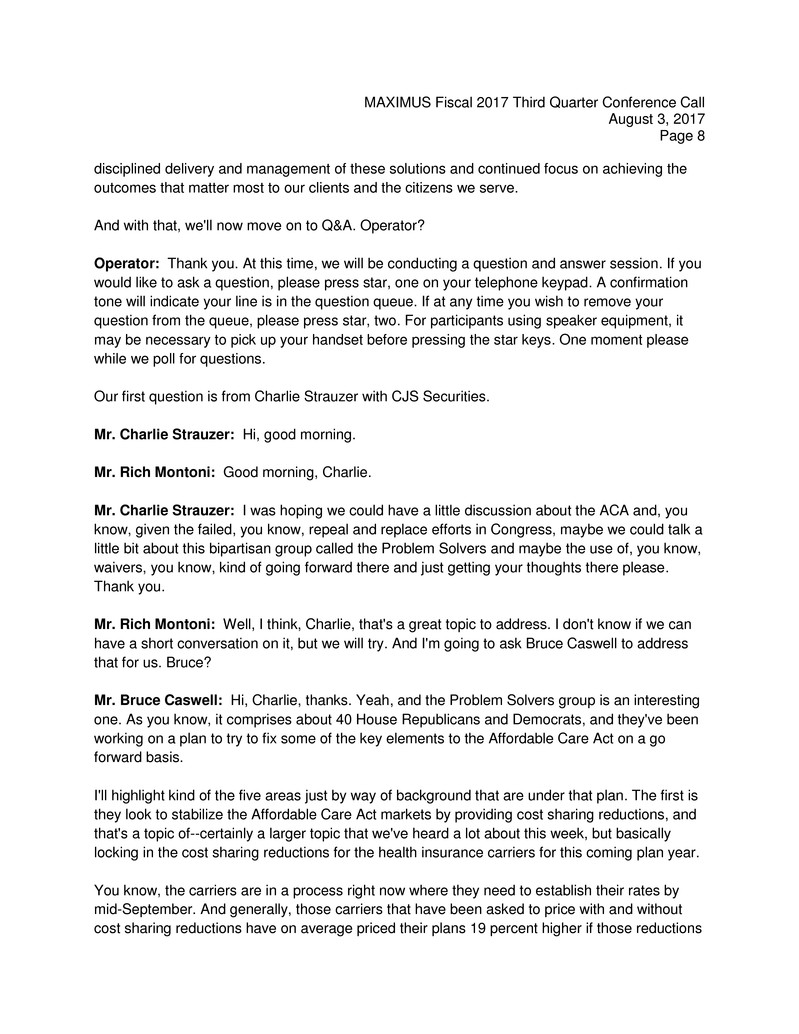
MAXIMUS Fiscal 2017 Third Quarter Conference Call
August 3, 2017
Page 8
disciplined delivery and management of these solutions and continued focus on achieving the
outcomes that matter most to our clients and the citizens we serve.
And with that, we'll now move on to Q&A. Operator?
Operator: Thank you. At this time, we will be conducting a question and answer session. If you
would like to ask a question, please press star, one on your telephone keypad. A confirmation
tone will indicate your line is in the question queue. If at any time you wish to remove your
question from the queue, please press star, two. For participants using speaker equipment, it
may be necessary to pick up your handset before pressing the star keys. One moment please
while we poll for questions.
Our first question is from Charlie Strauzer with CJS Securities.
Mr. Charlie Strauzer: Hi, good morning.
Mr. Rich Montoni: Good morning, Charlie.
Mr. Charlie Strauzer: I was hoping we could have a little discussion about the ACA and, you
know, given the failed, you know, repeal and replace efforts in Congress, maybe we could talk a
little bit about this bipartisan group called the Problem Solvers and maybe the use of, you know,
waivers, you know, kind of going forward there and just getting your thoughts there please.
Thank you.
Mr. Rich Montoni: Well, I think, Charlie, that's a great topic to address. I don't know if we can
have a short conversation on it, but we will try. And I'm going to ask Bruce Caswell to address
that for us. Bruce?
Mr. Bruce Caswell: Hi, Charlie, thanks. Yeah, and the Problem Solvers group is an interesting
one. As you know, it comprises about 40 House Republicans and Democrats, and they've been
working on a plan to try to fix some of the key elements to the Affordable Care Act on a go
forward basis.
I'll highlight kind of the five areas just by way of background that are under that plan. The first is
they look to stabilize the Affordable Care Act markets by providing cost sharing reductions, and
that's a topic of--certainly a larger topic that we've heard a lot about this week, but basically
locking in the cost sharing reductions for the health insurance carriers for this coming plan year.
You know, the carriers are in a process right now where they need to establish their rates by
mid-September. And generally, those carriers that have been asked to price with and without
cost sharing reductions have on average priced their plans 19 percent higher if those reductions

MAXIMUS Fiscal 2017 Third Quarter Conference Call
August 3, 2017
Page 9
do not exist. So, they have the potential if they don't exist to destabilize the insurance market in
the sense that there are about, oh, 7 million Americans that have relied historically on about $7
billion in these cost sharing reductions, and those are low income Americans between 100 and
250 percent of the federal poverty level.
The second area that they're focused on is changing the employer mandate and have that apply
to companies with 500 employees or more rather than 50 workers and also kind of a technical
fix to the 40 hour work week requirement. Third, the creation of a federal stability fund that
states would be able to tap into to reduce premiums and cost for people that have really
expensive health care needs, and then fourthly, repeal of the medical device tax, which actually
is something that's enjoyed bipartisan support for some time, and then last, really providing--and
this goes, you know, to the end of your question--greater flexibility to states for innovation.
There have been provisions in the Affordable Care Act known as the Widen Waivers and/or
Section 1332 Waivers of the Affordable Care Act that for years have allowed states to really
craft, if you will, their own flavor for the local insurance markets and really create programs that
best address the needs of their local markets. But, it's not been super clear to states as to how
to get through that process. So, this group seeks to provide additional guidance.
So, when we look at this thing across the board, we think that, if the Problem Solvers are able to
make progress, it's the kind of situation that could be neutral to net positive for MAXIMUS. We
were one of the very first companies, in fact, that got out there and did webinars and policy
briefings on the 1332 process and have been working with a number of our clients to
understand their intent as it relates to 1332. And as we transition from the Obama
Administration to the Trump Administration, there's actually a backlog of waivers that have yet to
be fully adjudicated by CMS, and there are in fact four states at least that have 1332 waivers
pending.
So, I think we're all going to be watching the progress of the Problem Solvers, and we'll see
where it goes from here. But, certainly, there are some very attractive elements of what they're
trying to accomplish that would address some of the current deficiencies in the act.
Mr. Rich Montoni: Thanks, Bruce. Next question please.
Operator: Our next question is from Jamie Stockton with Wells Fargo.
Mr. Jamie Stockton: Hey, good morning. Thanks for taking my questions. I guess maybe, you
know, there's a lot of talk about automation. You guys saw, you know, nice operating margin
improvement year over year if you exclude the one timer last year. Can you give us some sense
for how much runway is left there?
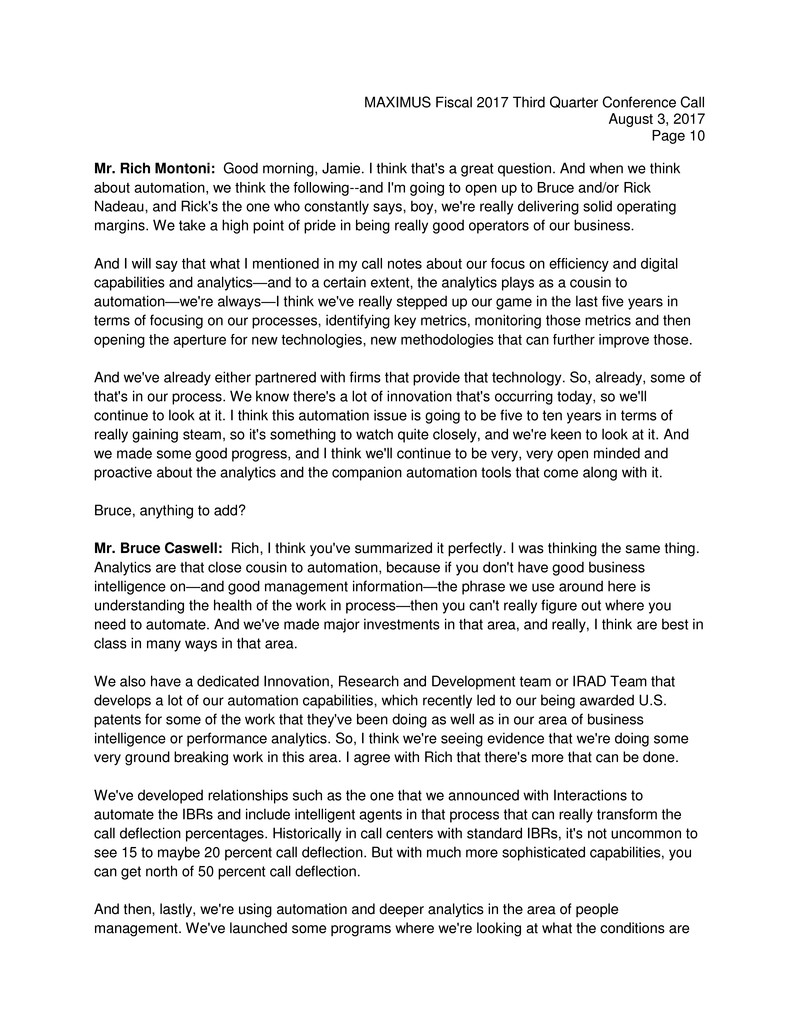
MAXIMUS Fiscal 2017 Third Quarter Conference Call
August 3, 2017
Page 10
Mr. Rich Montoni: Good morning, Jamie. I think that's a great question. And when we think
about automation, we think the following--and I'm going to open up to Bruce and/or Rick
Nadeau, and Rick's the one who constantly says, boy, we're really delivering solid operating
margins. We take a high point of pride in being really good operators of our business.
And I will say that what I mentioned in my call notes about our focus on efficiency and digital
capabilities and analytics—and to a certain extent, the analytics plays as a cousin to
automation—we're always—I think we've really stepped up our game in the last five years in
terms of focusing on our processes, identifying key metrics, monitoring those metrics and then
opening the aperture for new technologies, new methodologies that can further improve those.
And we've already either partnered with firms that provide that technology. So, already, some of
that's in our process. We know there's a lot of innovation that's occurring today, so we'll
continue to look at it. I think this automation issue is going to be five to ten years in terms of
really gaining steam, so it's something to watch quite closely, and we're keen to look at it. And
we made some good progress, and I think we'll continue to be very, very open minded and
proactive about the analytics and the companion automation tools that come along with it.
Bruce, anything to add?
Mr. Bruce Caswell: Rich, I think you've summarized it perfectly. I was thinking the same thing.
Analytics are that close cousin to automation, because if you don't have good business
intelligence on—and good management information—the phrase we use around here is
understanding the health of the work in process—then you can't really figure out where you
need to automate. And we've made major investments in that area, and really, I think are best in
class in many ways in that area.
We also have a dedicated Innovation, Research and Development team or IRAD Team that
develops a lot of our automation capabilities, which recently led to our being awarded U.S.
patents for some of the work that they've been doing as well as in our area of business
intelligence or performance analytics. So, I think we're seeing evidence that we're doing some
very ground breaking work in this area. I agree with Rich that there's more that can be done.
We've developed relationships such as the one that we announced with Interactions to
automate the IBRs and include intelligent agents in that process that can really transform the
call deflection percentages. Historically in call centers with standard IBRs, it's not uncommon to
see 15 to maybe 20 percent call deflection. But with much more sophisticated capabilities, you
can get north of 50 percent call deflection.
And then, lastly, we're using automation and deeper analytics in the area of people
management. We've launched some programs where we're looking at what the conditions are
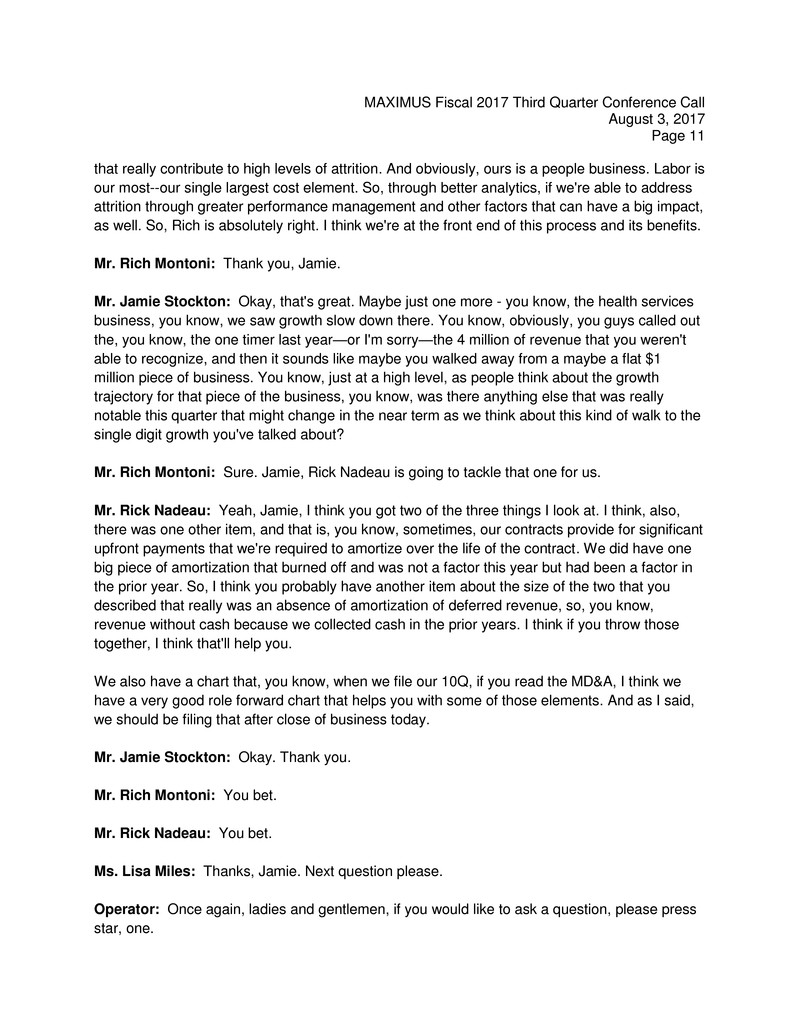
MAXIMUS Fiscal 2017 Third Quarter Conference Call
August 3, 2017
Page 11
that really contribute to high levels of attrition. And obviously, ours is a people business. Labor is
our most--our single largest cost element. So, through better analytics, if we're able to address
attrition through greater performance management and other factors that can have a big impact,
as well. So, Rich is absolutely right. I think we're at the front end of this process and its benefits.
Mr. Rich Montoni: Thank you, Jamie.
Mr. Jamie Stockton: Okay, that's great. Maybe just one more - you know, the health services
business, you know, we saw growth slow down there. You know, obviously, you guys called out
the, you know, the one timer last year—or I'm sorry—the 4 million of revenue that you weren't
able to recognize, and then it sounds like maybe you walked away from a maybe a flat $1
million piece of business. You know, just at a high level, as people think about the growth
trajectory for that piece of the business, you know, was there anything else that was really
notable this quarter that might change in the near term as we think about this kind of walk to the
single digit growth you've talked about?
Mr. Rich Montoni: Sure. Jamie, Rick Nadeau is going to tackle that one for us.
Mr. Rick Nadeau: Yeah, Jamie, I think you got two of the three things I look at. I think, also,
there was one other item, and that is, you know, sometimes, our contracts provide for significant
upfront payments that we're required to amortize over the life of the contract. We did have one
big piece of amortization that burned off and was not a factor this year but had been a factor in
the prior year. So, I think you probably have another item about the size of the two that you
described that really was an absence of amortization of deferred revenue, so, you know,
revenue without cash because we collected cash in the prior years. I think if you throw those
together, I think that'll help you.
We also have a chart that, you know, when we file our 10Q, if you read the MD&A, I think we
have a very good role forward chart that helps you with some of those elements. And as I said,
we should be filing that after close of business today.
Mr. Jamie Stockton: Okay. Thank you.
Mr. Rich Montoni: You bet.
Mr. Rick Nadeau: You bet.
Ms. Lisa Miles: Thanks, Jamie. Next question please.
Operator: Once again, ladies and gentlemen, if you would like to ask a question, please press
star, one.

MAXIMUS Fiscal 2017 Third Quarter Conference Call
August 3, 2017
Page 12
Our next question is from Brian Hoffman with Canaccord Genuity.
Mr. Brian Hoffman: Great. Good morning. Thank you for the question. As a follow up to the
health care question earlier, I know in recent months, we've heard some states talk about
implementing Medicaid work requirements. Curious if you're seeing any opportunities there yet
or other similar type Medicaid programs? And I know, earlier, you had mentioned that there's a
backlog of waivers that are pending. Would work requirements be tied to those waivers, or is
that different? Thanks.
Mr. Rich Montoni: Well, good morning, Brian. I'm going to comment on this, and then I'm
going to ask Bruce to comment, as well. I will say that what we hear quite frequently under the
banner of personal responsibility—and it's a very common and I think popular theme—you
know, if we move forward with significant changes to the Affordable Care Act, I think there's a
high likelihood that work requirements would become nationally part of the program.
And I do think we have some very significant state specific issues. And before Bruce jumps into
those particular views, I would add that, given the human services business that we have, we
think we're perhaps uniquely qualified to offer some pretty significant capabilities in that space
and marry those two capabilities as one service delivery. Bruce?
Mr. Bruce Caswell: I think you're absolutely right, Rich. And, Brian, to answer your question
about the existing waivers, there--my understanding is there are I think six Medicaid waivers
that are outstanding that kind of transitioned over from the Obama Administration from states
including Arkansas, Indiana, Kentucky, Maine, Massachusetts and Wisconsin. And some of
those do have, it's my understanding, a work requirement component related to them.
Overall, we're tracking about 10 states right now that have expressed an interest in a Medicaid
related work requirement, and we expect that the waiver process will likely take about three to
six months to get through approvals at CMS. And then from that point forward, we would start to
see RFPs or modifications to existing work to address that.
As Rich said, we do feel like we're very well positioned as a unique company that provides not
just the front end eligibility related services to help determine whether an individual is an able
bodied adult and would qualify for the waiver requirement but also then the employment
services component on the back end.
I think a critical question that states have to face is are they going to have these individuals seek
their employment services or meet that work requirement through the kind of traditional
workforce investment board process, which historically has not been performance based and
outcome oriented, or will they look instead at some of the models like we administer for the
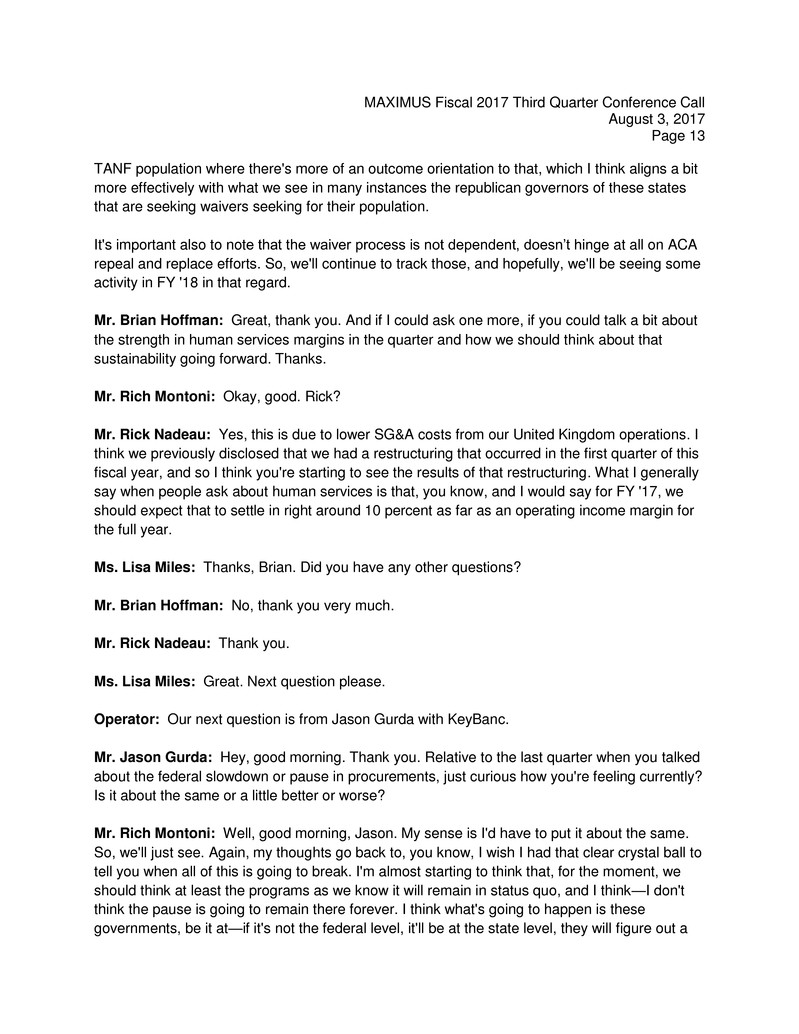
MAXIMUS Fiscal 2017 Third Quarter Conference Call
August 3, 2017
Page 13
TANF population where there's more of an outcome orientation to that, which I think aligns a bit
more effectively with what we see in many instances the republican governors of these states
that are seeking waivers seeking for their population.
It's important also to note that the waiver process is not dependent, doesn’t hinge at all on ACA
repeal and replace efforts. So, we'll continue to track those, and hopefully, we'll be seeing some
activity in FY '18 in that regard.
Mr. Brian Hoffman: Great, thank you. And if I could ask one more, if you could talk a bit about
the strength in human services margins in the quarter and how we should think about that
sustainability going forward. Thanks.
Mr. Rich Montoni: Okay, good. Rick?
Mr. Rick Nadeau: Yes, this is due to lower SG&A costs from our United Kingdom operations. I
think we previously disclosed that we had a restructuring that occurred in the first quarter of this
fiscal year, and so I think you're starting to see the results of that restructuring. What I generally
say when people ask about human services is that, you know, and I would say for FY '17, we
should expect that to settle in right around 10 percent as far as an operating income margin for
the full year.
Ms. Lisa Miles: Thanks, Brian. Did you have any other questions?
Mr. Brian Hoffman: No, thank you very much.
Mr. Rick Nadeau: Thank you.
Ms. Lisa Miles: Great. Next question please.
Operator: Our next question is from Jason Gurda with KeyBanc.
Mr. Jason Gurda: Hey, good morning. Thank you. Relative to the last quarter when you talked
about the federal slowdown or pause in procurements, just curious how you're feeling currently?
Is it about the same or a little better or worse?
Mr. Rich Montoni: Well, good morning, Jason. My sense is I'd have to put it about the same.
So, we'll just see. Again, my thoughts go back to, you know, I wish I had that clear crystal ball to
tell you when all of this is going to break. I'm almost starting to think that, for the moment, we
should think at least the programs as we know it will remain in status quo, and I think—I don't
think the pause is going to remain there forever. I think what's going to happen is these
governments, be it at—if it's not the federal level, it'll be at the state level, they will figure out a
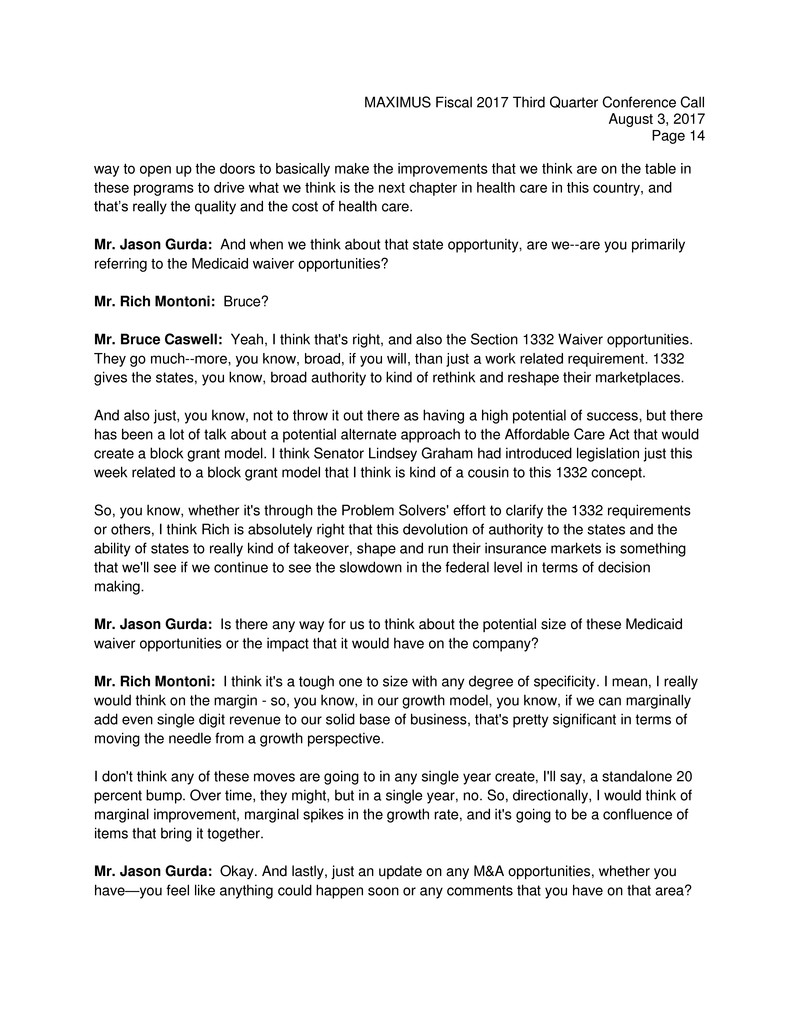
MAXIMUS Fiscal 2017 Third Quarter Conference Call
August 3, 2017
Page 14
way to open up the doors to basically make the improvements that we think are on the table in
these programs to drive what we think is the next chapter in health care in this country, and
that’s really the quality and the cost of health care.
Mr. Jason Gurda: And when we think about that state opportunity, are we--are you primarily
referring to the Medicaid waiver opportunities?
Mr. Rich Montoni: Bruce?
Mr. Bruce Caswell: Yeah, I think that's right, and also the Section 1332 Waiver opportunities.
They go much--more, you know, broad, if you will, than just a work related requirement. 1332
gives the states, you know, broad authority to kind of rethink and reshape their marketplaces.
And also just, you know, not to throw it out there as having a high potential of success, but there
has been a lot of talk about a potential alternate approach to the Affordable Care Act that would
create a block grant model. I think Senator Lindsey Graham had introduced legislation just this
week related to a block grant model that I think is kind of a cousin to this 1332 concept.
So, you know, whether it's through the Problem Solvers' effort to clarify the 1332 requirements
or others, I think Rich is absolutely right that this devolution of authority to the states and the
ability of states to really kind of takeover, shape and run their insurance markets is something
that we'll see if we continue to see the slowdown in the federal level in terms of decision
making.
Mr. Jason Gurda: Is there any way for us to think about the potential size of these Medicaid
waiver opportunities or the impact that it would have on the company?
Mr. Rich Montoni: I think it's a tough one to size with any degree of specificity. I mean, I really
would think on the margin - so, you know, in our growth model, you know, if we can marginally
add even single digit revenue to our solid base of business, that's pretty significant in terms of
moving the needle from a growth perspective.
I don't think any of these moves are going to in any single year create, I'll say, a standalone 20
percent bump. Over time, they might, but in a single year, no. So, directionally, I would think of
marginal improvement, marginal spikes in the growth rate, and it's going to be a confluence of
items that bring it together.
Mr. Jason Gurda: Okay. And lastly, just an update on any M&A opportunities, whether you
have—you feel like anything could happen soon or any comments that you have on that area?
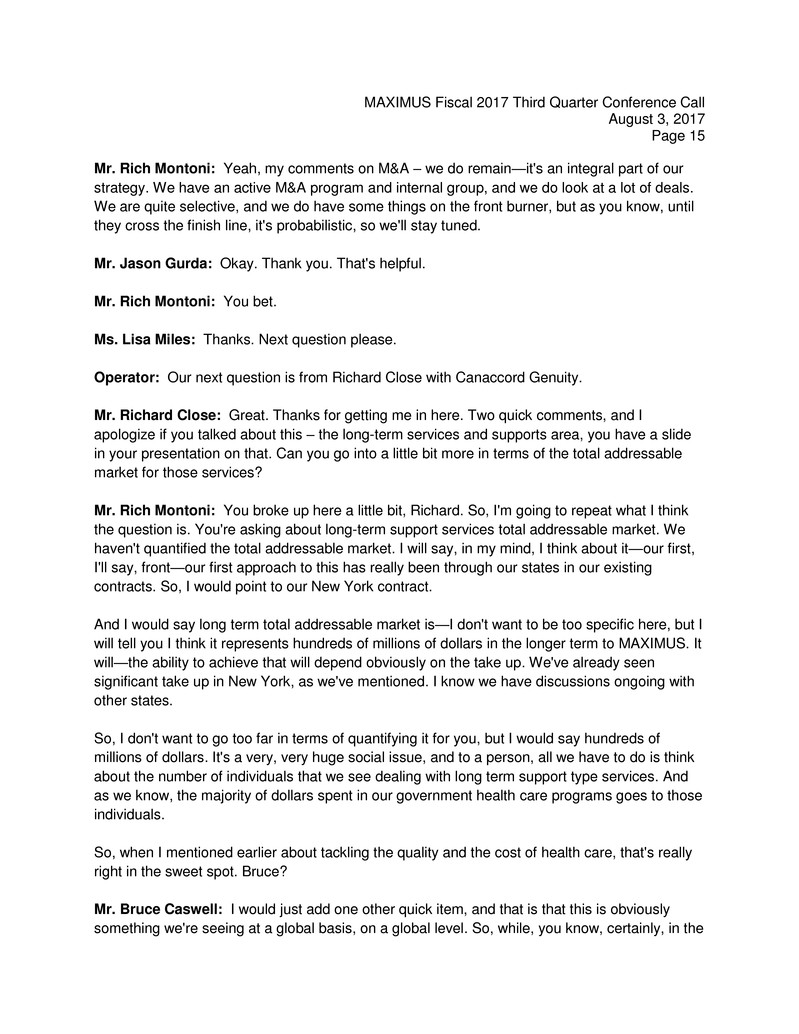
MAXIMUS Fiscal 2017 Third Quarter Conference Call
August 3, 2017
Page 15
Mr. Rich Montoni: Yeah, my comments on M&A – we do remain—it's an integral part of our
strategy. We have an active M&A program and internal group, and we do look at a lot of deals.
We are quite selective, and we do have some things on the front burner, but as you know, until
they cross the finish line, it's probabilistic, so we'll stay tuned.
Mr. Jason Gurda: Okay. Thank you. That's helpful.
Mr. Rich Montoni: You bet.
Ms. Lisa Miles: Thanks. Next question please.
Operator: Our next question is from Richard Close with Canaccord Genuity.
Mr. Richard Close: Great. Thanks for getting me in here. Two quick comments, and I
apologize if you talked about this – the long-term services and supports area, you have a slide
in your presentation on that. Can you go into a little bit more in terms of the total addressable
market for those services?
Mr. Rich Montoni: You broke up here a little bit, Richard. So, I'm going to repeat what I think
the question is. You're asking about long-term support services total addressable market. We
haven't quantified the total addressable market. I will say, in my mind, I think about it—our first,
I'll say, front—our first approach to this has really been through our states in our existing
contracts. So, I would point to our New York contract.
And I would say long term total addressable market is—I don't want to be too specific here, but I
will tell you I think it represents hundreds of millions of dollars in the longer term to MAXIMUS. It
will—the ability to achieve that will depend obviously on the take up. We've already seen
significant take up in New York, as we've mentioned. I know we have discussions ongoing with
other states.
So, I don't want to go too far in terms of quantifying it for you, but I would say hundreds of
millions of dollars. It's a very, very huge social issue, and to a person, all we have to do is think
about the number of individuals that we see dealing with long term support type services. And
as we know, the majority of dollars spent in our government health care programs goes to those
individuals.
So, when I mentioned earlier about tackling the quality and the cost of health care, that's really
right in the sweet spot. Bruce?
Mr. Bruce Caswell: I would just add one other quick item, and that is that this is obviously
something we're seeing at a global basis, on a global level. So, while, you know, certainly, in the
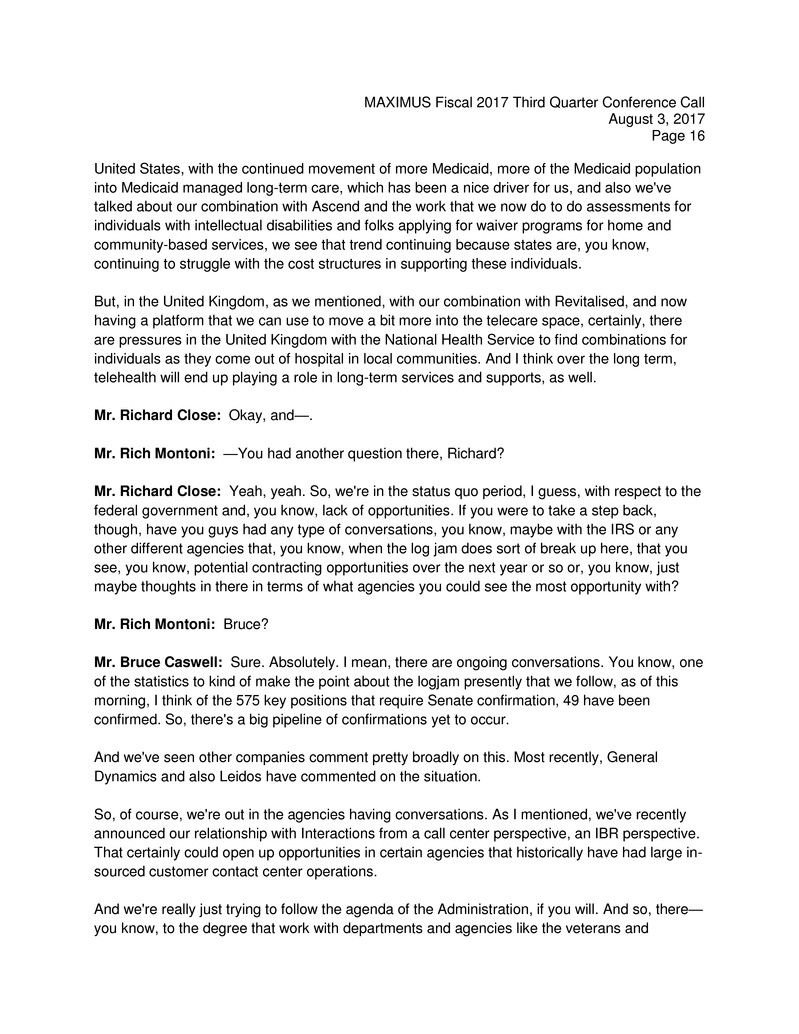
MAXIMUS Fiscal 2017 Third Quarter Conference Call
August 3, 2017
Page 16
United States, with the continued movement of more Medicaid, more of the Medicaid population
into Medicaid managed long-term care, which has been a nice driver for us, and also we've
talked about our combination with Ascend and the work that we now do to do assessments for
individuals with intellectual disabilities and folks applying for waiver programs for home and
community-based services, we see that trend continuing because states are, you know,
continuing to struggle with the cost structures in supporting these individuals.
But, in the United Kingdom, as we mentioned, with our combination with Revitalised, and now
having a platform that we can use to move a bit more into the telecare space, certainly, there
are pressures in the United Kingdom with the National Health Service to find combinations for
individuals as they come out of hospital in local communities. And I think over the long term,
telehealth will end up playing a role in long-term services and supports, as well.
Mr. Richard Close: Okay, and—.
Mr. Rich Montoni: —You had another question there, Richard?
Mr. Richard Close: Yeah, yeah. So, we're in the status quo period, I guess, with respect to the
federal government and, you know, lack of opportunities. If you were to take a step back,
though, have you guys had any type of conversations, you know, maybe with the IRS or any
other different agencies that, you know, when the log jam does sort of break up here, that you
see, you know, potential contracting opportunities over the next year or so or, you know, just
maybe thoughts in there in terms of what agencies you could see the most opportunity with?
Mr. Rich Montoni: Bruce?
Mr. Bruce Caswell: Sure. Absolutely. I mean, there are ongoing conversations. You know, one
of the statistics to kind of make the point about the logjam presently that we follow, as of this
morning, I think of the 575 key positions that require Senate confirmation, 49 have been
confirmed. So, there's a big pipeline of confirmations yet to occur.
And we've seen other companies comment pretty broadly on this. Most recently, General
Dynamics and also Leidos have commented on the situation.
So, of course, we're out in the agencies having conversations. As I mentioned, we've recently
announced our relationship with Interactions from a call center perspective, an IBR perspective.
That certainly could open up opportunities in certain agencies that historically have had large in-
sourced customer contact center operations.
And we're really just trying to follow the agenda of the Administration, if you will. And so, there—
you know, to the degree that work with departments and agencies like the veterans and
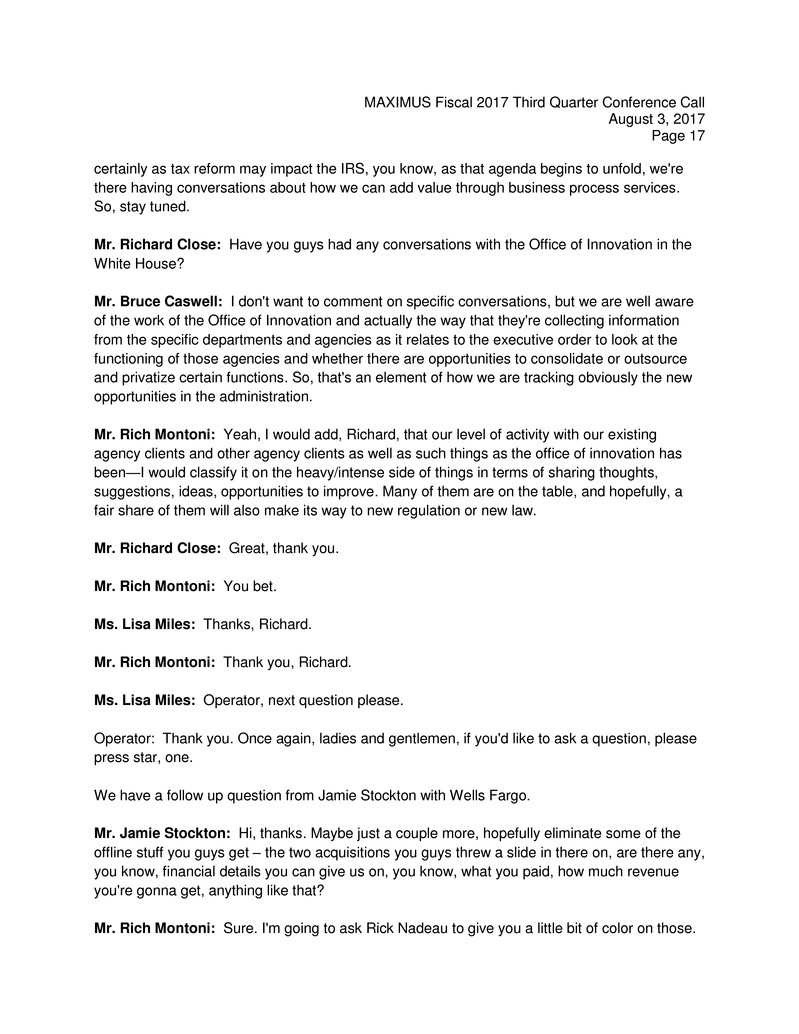
MAXIMUS Fiscal 2017 Third Quarter Conference Call
August 3, 2017
Page 17
certainly as tax reform may impact the IRS, you know, as that agenda begins to unfold, we're
there having conversations about how we can add value through business process services.
So, stay tuned.
Mr. Richard Close: Have you guys had any conversations with the Office of Innovation in the
White House?
Mr. Bruce Caswell: I don't want to comment on specific conversations, but we are well aware
of the work of the Office of Innovation and actually the way that they're collecting information
from the specific departments and agencies as it relates to the executive order to look at the
functioning of those agencies and whether there are opportunities to consolidate or outsource
and privatize certain functions. So, that's an element of how we are tracking obviously the new
opportunities in the administration.
Mr. Rich Montoni: Yeah, I would add, Richard, that our level of activity with our existing
agency clients and other agency clients as well as such things as the office of innovation has
been—I would classify it on the heavy/intense side of things in terms of sharing thoughts,
suggestions, ideas, opportunities to improve. Many of them are on the table, and hopefully, a
fair share of them will also make its way to new regulation or new law.
Mr. Richard Close: Great, thank you.
Mr. Rich Montoni: You bet.
Ms. Lisa Miles: Thanks, Richard.
Mr. Rich Montoni: Thank you, Richard.
Ms. Lisa Miles: Operator, next question please.
Operator: Thank you. Once again, ladies and gentlemen, if you'd like to ask a question, please
press star, one.
We have a follow up question from Jamie Stockton with Wells Fargo.
Mr. Jamie Stockton: Hi, thanks. Maybe just a couple more, hopefully eliminate some of the
offline stuff you guys get – the two acquisitions you guys threw a slide in there on, are there any,
you know, financial details you can give us on, you know, what you paid, how much revenue
you're gonna get, anything like that?
Mr. Rich Montoni: Sure. I'm going to ask Rick Nadeau to give you a little bit of color on those.

MAXIMUS Fiscal 2017 Third Quarter Conference Call
August 3, 2017
Page 18
Mr. Rick Nadeau: Yeah, you're asking about Revitalised, for one. Yeah, we paid $2.8 million.
There's also a contingent consideration piece that will be tied to their future success of sales,
and that's $1.6 million. It's relatively small, but as we said, it's in the United Kingdom, and it's,
you know, it's critical types of skills that we wanted to capture. What was the other one?
Mr. Jamie Stockton: [Unintelligible.]
Mr. Rich Montoni: I think Ascend was the one that was mentioned. Was it Ascend?
Mr. Rick Nadeau: Oh, it happened in prior quarters. The reason I'm confused is Ascend is--
was February 29th of last year. So, I'm sorry, your question on that one is?
Mr. Jamie Stockton: Oh, I'm sorry. The slide you threw in there brought up Health
Management, and I didn't know if that was a recent--.
Ms. Lisa Miles: --Oh, that was--.
Mr. Rick Nadeau: --Oh, no, HML was a 2013 transaction.
Mr. Jamie Stockton: Okay.
Mr. Rich Nadeau: The point that Rich was making was that was an acquisition that enabled us
to have the skills to bid HAAS and so that was the reason we brought that back up.
Mr. Rich Montoni: So, Revitalised was the only acquisition in the quarter, Jamie.
Mr. Jamie Stockton: Okay, that's great. My other question was, you know, you guys are
having a blowout year from a cash flow standpoint. When I look back at kind of prior years, you
know, there was kind of a consistent investment that you were having to make in working capital
that isn't happening this year. And, you know, I would just love any thoughts you might have
around whether, you know, that is something that is sustainable or is it something that might just
be more transitory because of this paused environment?
Mr. Rich Montoni: Well, I'm going to—Rick's going to answer it. I'll give you a macro or a high
level answer, and I said it's an interesting observation you make. And what comes to my mind is
the fact that our business development cycle is oftentimes multiyear in nature. And when you
study the consequences, the financial consequences of that model year by year by year, you do
get some very interesting fluctuations. And what would you add to that, Rick?
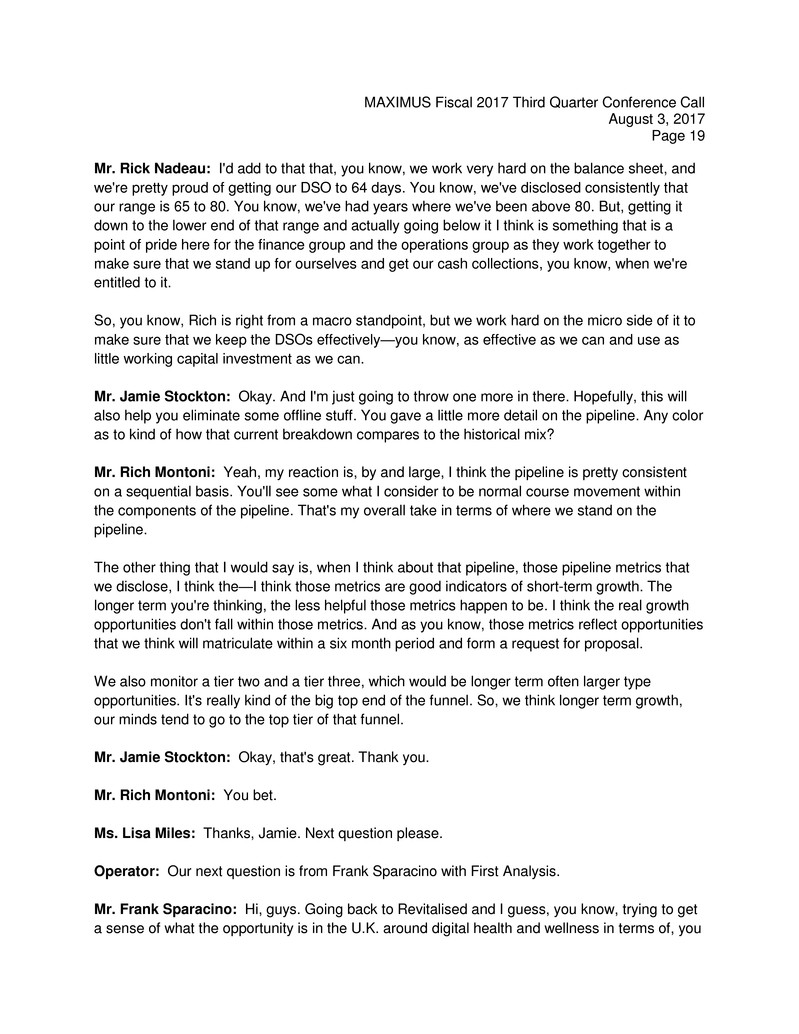
MAXIMUS Fiscal 2017 Third Quarter Conference Call
August 3, 2017
Page 19
Mr. Rick Nadeau: I'd add to that that, you know, we work very hard on the balance sheet, and
we're pretty proud of getting our DSO to 64 days. You know, we've disclosed consistently that
our range is 65 to 80. You know, we've had years where we've been above 80. But, getting it
down to the lower end of that range and actually going below it I think is something that is a
point of pride here for the finance group and the operations group as they work together to
make sure that we stand up for ourselves and get our cash collections, you know, when we're
entitled to it.
So, you know, Rich is right from a macro standpoint, but we work hard on the micro side of it to
make sure that we keep the DSOs effectively—you know, as effective as we can and use as
little working capital investment as we can.
Mr. Jamie Stockton: Okay. And I'm just going to throw one more in there. Hopefully, this will
also help you eliminate some offline stuff. You gave a little more detail on the pipeline. Any color
as to kind of how that current breakdown compares to the historical mix?
Mr. Rich Montoni: Yeah, my reaction is, by and large, I think the pipeline is pretty consistent
on a sequential basis. You'll see some what I consider to be normal course movement within
the components of the pipeline. That's my overall take in terms of where we stand on the
pipeline.
The other thing that I would say is, when I think about that pipeline, those pipeline metrics that
we disclose, I think the—I think those metrics are good indicators of short-term growth. The
longer term you're thinking, the less helpful those metrics happen to be. I think the real growth
opportunities don't fall within those metrics. And as you know, those metrics reflect opportunities
that we think will matriculate within a six month period and form a request for proposal.
We also monitor a tier two and a tier three, which would be longer term often larger type
opportunities. It's really kind of the big top end of the funnel. So, we think longer term growth,
our minds tend to go to the top tier of that funnel.
Mr. Jamie Stockton: Okay, that's great. Thank you.
Mr. Rich Montoni: You bet.
Ms. Lisa Miles: Thanks, Jamie. Next question please.
Operator: Our next question is from Frank Sparacino with First Analysis.
Mr. Frank Sparacino: Hi, guys. Going back to Revitalised and I guess, you know, trying to get
a sense of what the opportunity is in the U.K. around digital health and wellness in terms of, you
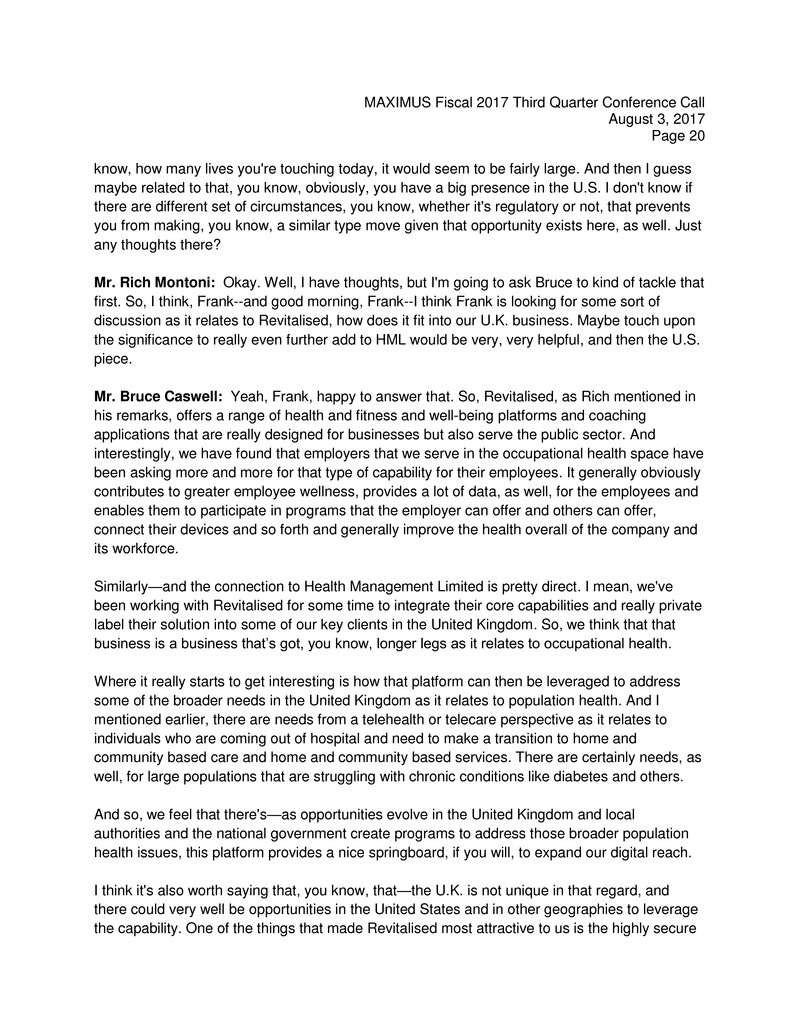
MAXIMUS Fiscal 2017 Third Quarter Conference Call
August 3, 2017
Page 20
know, how many lives you're touching today, it would seem to be fairly large. And then I guess
maybe related to that, you know, obviously, you have a big presence in the U.S. I don't know if
there are different set of circumstances, you know, whether it's regulatory or not, that prevents
you from making, you know, a similar type move given that opportunity exists here, as well. Just
any thoughts there?
Mr. Rich Montoni: Okay. Well, I have thoughts, but I'm going to ask Bruce to kind of tackle that
first. So, I think, Frank--and good morning, Frank--I think Frank is looking for some sort of
discussion as it relates to Revitalised, how does it fit into our U.K. business. Maybe touch upon
the significance to really even further add to HML would be very, very helpful, and then the U.S.
piece.
Mr. Bruce Caswell: Yeah, Frank, happy to answer that. So, Revitalised, as Rich mentioned in
his remarks, offers a range of health and fitness and well-being platforms and coaching
applications that are really designed for businesses but also serve the public sector. And
interestingly, we have found that employers that we serve in the occupational health space have
been asking more and more for that type of capability for their employees. It generally obviously
contributes to greater employee wellness, provides a lot of data, as well, for the employees and
enables them to participate in programs that the employer can offer and others can offer,
connect their devices and so forth and generally improve the health overall of the company and
its workforce.
Similarly—and the connection to Health Management Limited is pretty direct. I mean, we've
been working with Revitalised for some time to integrate their core capabilities and really private
label their solution into some of our key clients in the United Kingdom. So, we think that that
business is a business that’s got, you know, longer legs as it relates to occupational health.
Where it really starts to get interesting is how that platform can then be leveraged to address
some of the broader needs in the United Kingdom as it relates to population health. And I
mentioned earlier, there are needs from a telehealth or telecare perspective as it relates to
individuals who are coming out of hospital and need to make a transition to home and
community based care and home and community based services. There are certainly needs, as
well, for large populations that are struggling with chronic conditions like diabetes and others.
And so, we feel that there's—as opportunities evolve in the United Kingdom and local
authorities and the national government create programs to address those broader population
health issues, this platform provides a nice springboard, if you will, to expand our digital reach.
I think it's also worth saying that, you know, that—the U.K. is not unique in that regard, and
there could very well be opportunities in the United States and in other geographies to leverage
the capability. One of the things that made Revitalised most attractive to us is the highly secure
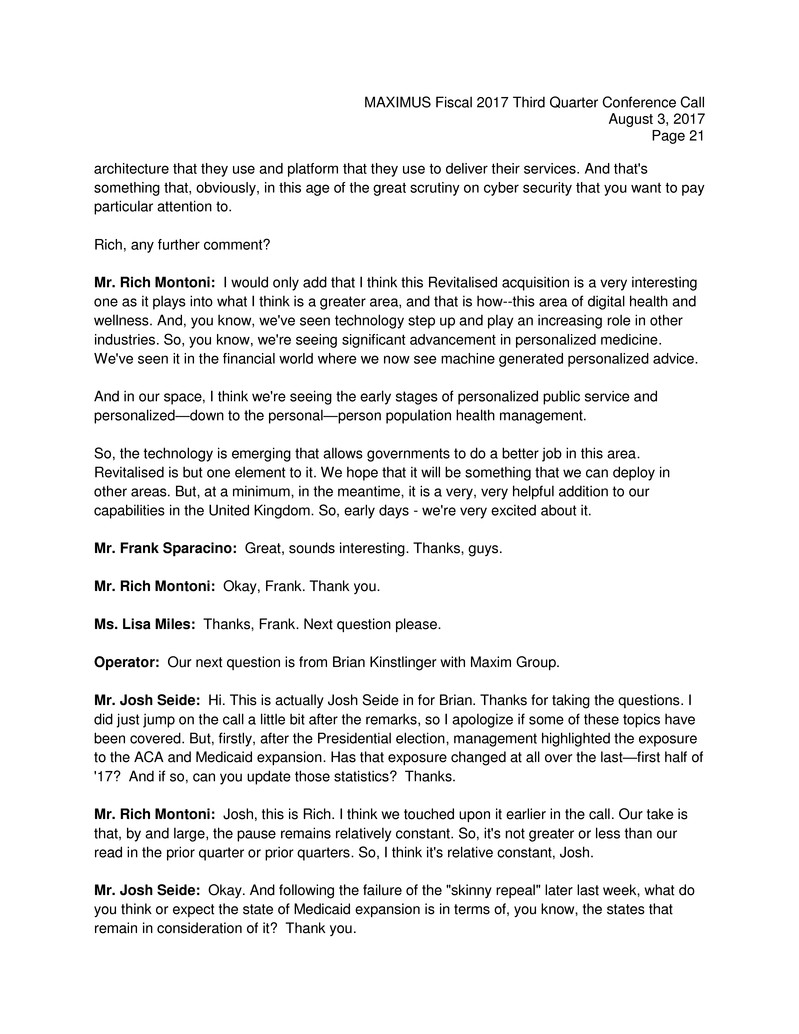
MAXIMUS Fiscal 2017 Third Quarter Conference Call
August 3, 2017
Page 21
architecture that they use and platform that they use to deliver their services. And that's
something that, obviously, in this age of the great scrutiny on cyber security that you want to pay
particular attention to.
Rich, any further comment?
Mr. Rich Montoni: I would only add that I think this Revitalised acquisition is a very interesting
one as it plays into what I think is a greater area, and that is how--this area of digital health and
wellness. And, you know, we've seen technology step up and play an increasing role in other
industries. So, you know, we're seeing significant advancement in personalized medicine.
We've seen it in the financial world where we now see machine generated personalized advice.
And in our space, I think we're seeing the early stages of personalized public service and
personalized—down to the personal—person population health management.
So, the technology is emerging that allows governments to do a better job in this area.
Revitalised is but one element to it. We hope that it will be something that we can deploy in
other areas. But, at a minimum, in the meantime, it is a very, very helpful addition to our
capabilities in the United Kingdom. So, early days - we're very excited about it.
Mr. Frank Sparacino: Great, sounds interesting. Thanks, guys.
Mr. Rich Montoni: Okay, Frank. Thank you.
Ms. Lisa Miles: Thanks, Frank. Next question please.
Operator: Our next question is from Brian Kinstlinger with Maxim Group.
Mr. Josh Seide: Hi. This is actually Josh Seide in for Brian. Thanks for taking the questions. I
did just jump on the call a little bit after the remarks, so I apologize if some of these topics have
been covered. But, firstly, after the Presidential election, management highlighted the exposure
to the ACA and Medicaid expansion. Has that exposure changed at all over the last—first half of
'17? And if so, can you update those statistics? Thanks.
Mr. Rich Montoni: Josh, this is Rich. I think we touched upon it earlier in the call. Our take is
that, by and large, the pause remains relatively constant. So, it's not greater or less than our
read in the prior quarter or prior quarters. So, I think it's relative constant, Josh.
Mr. Josh Seide: Okay. And following the failure of the "skinny repeal" later last week, what do
you think or expect the state of Medicaid expansion is in terms of, you know, the states that
remain in consideration of it? Thank you.
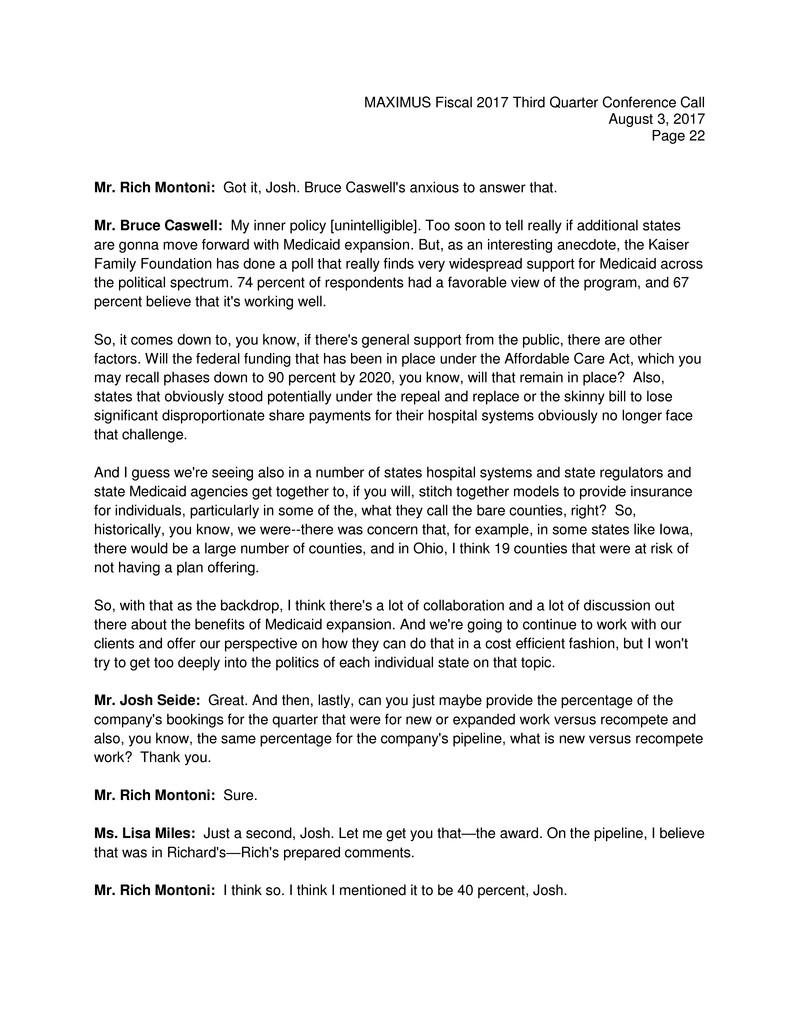
MAXIMUS Fiscal 2017 Third Quarter Conference Call
August 3, 2017
Page 22
Mr. Rich Montoni: Got it, Josh. Bruce Caswell's anxious to answer that.
Mr. Bruce Caswell: My inner policy [unintelligible]. Too soon to tell really if additional states
are gonna move forward with Medicaid expansion. But, as an interesting anecdote, the Kaiser
Family Foundation has done a poll that really finds very widespread support for Medicaid across
the political spectrum. 74 percent of respondents had a favorable view of the program, and 67
percent believe that it's working well.
So, it comes down to, you know, if there's general support from the public, there are other
factors. Will the federal funding that has been in place under the Affordable Care Act, which you
may recall phases down to 90 percent by 2020, you know, will that remain in place? Also,
states that obviously stood potentially under the repeal and replace or the skinny bill to lose
significant disproportionate share payments for their hospital systems obviously no longer face
that challenge.
And I guess we're seeing also in a number of states hospital systems and state regulators and
state Medicaid agencies get together to, if you will, stitch together models to provide insurance
for individuals, particularly in some of the, what they call the bare counties, right? So,
historically, you know, we were--there was concern that, for example, in some states like Iowa,
there would be a large number of counties, and in Ohio, I think 19 counties that were at risk of
not having a plan offering.
So, with that as the backdrop, I think there's a lot of collaboration and a lot of discussion out
there about the benefits of Medicaid expansion. And we're going to continue to work with our
clients and offer our perspective on how they can do that in a cost efficient fashion, but I won't
try to get too deeply into the politics of each individual state on that topic.
Mr. Josh Seide: Great. And then, lastly, can you just maybe provide the percentage of the
company's bookings for the quarter that were for new or expanded work versus recompete and
also, you know, the same percentage for the company's pipeline, what is new versus recompete
work? Thank you.
Mr. Rich Montoni: Sure.
Ms. Lisa Miles: Just a second, Josh. Let me get you that—the award. On the pipeline, I believe
that was in Richard's—Rich's prepared comments.
Mr. Rich Montoni: I think so. I think I mentioned it to be 40 percent, Josh.
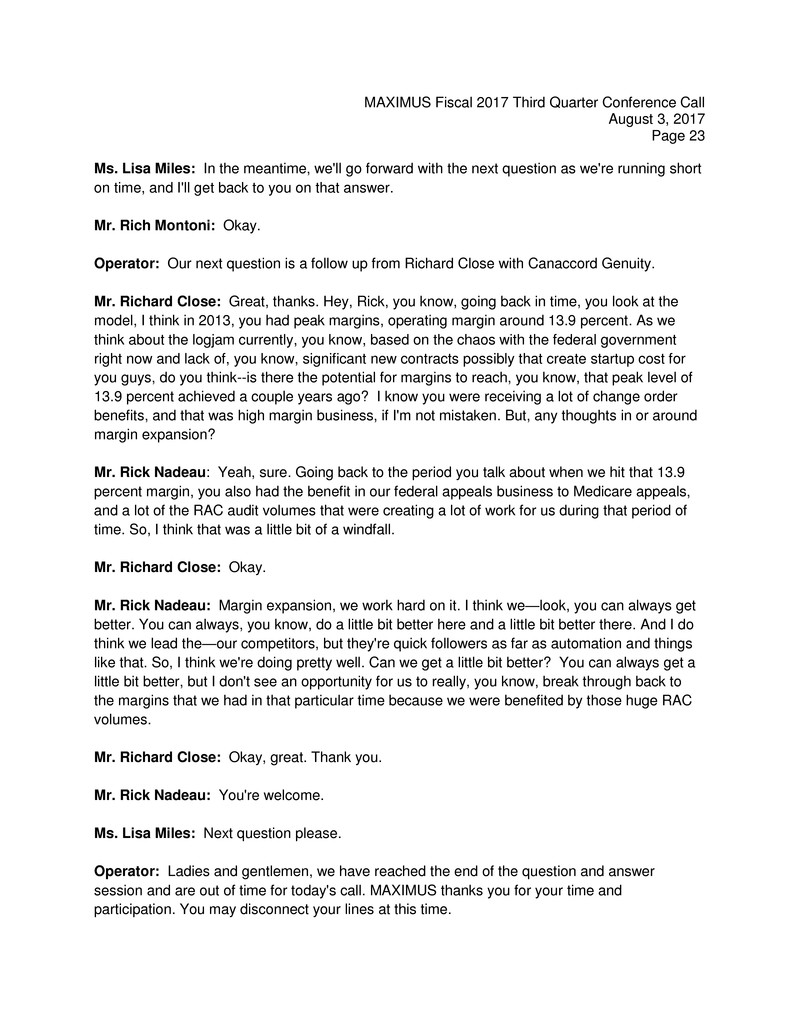
MAXIMUS Fiscal 2017 Third Quarter Conference Call
August 3, 2017
Page 23
Ms. Lisa Miles: In the meantime, we'll go forward with the next question as we're running short
on time, and I'll get back to you on that answer.
Mr. Rich Montoni: Okay.
Operator: Our next question is a follow up from Richard Close with Canaccord Genuity.
Mr. Richard Close: Great, thanks. Hey, Rick, you know, going back in time, you look at the
model, I think in 2013, you had peak margins, operating margin around 13.9 percent. As we
think about the logjam currently, you know, based on the chaos with the federal government
right now and lack of, you know, significant new contracts possibly that create startup cost for
you guys, do you think--is there the potential for margins to reach, you know, that peak level of
13.9 percent achieved a couple years ago? I know you were receiving a lot of change order
benefits, and that was high margin business, if I'm not mistaken. But, any thoughts in or around
margin expansion?
Mr. Rick Nadeau: Yeah, sure. Going back to the period you talk about when we hit that 13.9
percent margin, you also had the benefit in our federal appeals business to Medicare appeals,
and a lot of the RAC audit volumes that were creating a lot of work for us during that period of
time. So, I think that was a little bit of a windfall.
Mr. Richard Close: Okay.
Mr. Rick Nadeau: Margin expansion, we work hard on it. I think we—look, you can always get
better. You can always, you know, do a little bit better here and a little bit better there. And I do
think we lead the—our competitors, but they're quick followers as far as automation and things
like that. So, I think we're doing pretty well. Can we get a little bit better? You can always get a
little bit better, but I don't see an opportunity for us to really, you know, break through back to
the margins that we had in that particular time because we were benefited by those huge RAC
volumes.
Mr. Richard Close: Okay, great. Thank you.
Mr. Rick Nadeau: You're welcome.
Ms. Lisa Miles: Next question please.
Operator: Ladies and gentlemen, we have reached the end of the question and answer
session and are out of time for today's call. MAXIMUS thanks you for your time and
participation. You may disconnect your lines at this time.